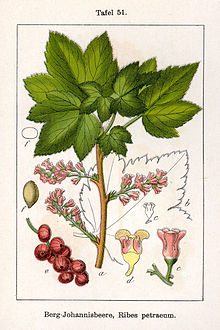Rock currant
| Rock currant | ||||||||||||
|---|---|---|---|---|---|---|---|---|---|---|---|---|

Rock currant ( Ribes petraeum ) |
||||||||||||
| Systematics | ||||||||||||
|
||||||||||||
| Scientific name | ||||||||||||
| Ribes petraeum | ||||||||||||
| Wulfen |
The rock-currant ( Ribes petraeum ) is an up to now not endangered plant species from the family of gooseberry plants ( Grossulariaceae ), which in Central Europe is primarily in the Black Forest , in the Vosges , Sudeten and in the central Alps on a humic substrate in a low lime occurs rock . The distribution area extends overall to Asia and North Africa.
features
The plant is a deciduous shrub that can reach a height of 2.8 meters. It differs from the closely related alpine currant in its flower bracts , which are shorter than the flower stalks, and in the sepals , which are often still attached to the ripe berries and have white eyelashes about 0.1 to 0.2 mm long are, as well as at the fruit time by the hanging grapes. A taste test of the berries gives an extremely sour result. The petiole is often longer than the leaf.
The species has chromosome number 2n = 16.
Locations and socialization
The plant prefers a humus soil in lime-poor mountains at heights of 800 to about 2450 meters. However, the rock currant can also be found in the calcareous Swabian Alb and the Swiss Jura . Considerable populations have also been mapped in the Mangfall Mountains in the Northern Limestone Alps, as well as in the vicinity of the Blecksteinhaus Alpine Club Hut in the Valepptal . The pH value of the soil there is 4.8 to 5.5, i.e. a strongly acidic soil with a high proportion of humus.
The rock currant occurs in alpine high herbaceous meadows, mixed mountain forests and bushes. In Bavaria there are also stands of striped fern spruce forests or block spruce forests . It is regionally a species of Aceri-Fagetum, but also occurs in other societies of the Betulo-Adenostyletea class.
Research history
First described the rock-currant in 1728 was born in Belgrade Baron Franz Xaver von Wulfen . He found the shrub near Lienz and named it Ribes petraeum in 1781 . The name comes from the Greek πεταιος , which means growing on rocks .
Individual evidence
- ^ Gustav Hegi : Illustrierte Flora von Mitteleuropa , Volume IV, P. Parey, Berlin and Hamburg 1975, p. 49
- ↑ Jaakko Jalas, Juha Suominen, Raino Lampinen, Arto Kurtto: Atlas florae europaeae . Volume 12 (Resedaceae to Platanaceae). Page 232, Helsinki 1999. ISBN 951-9108-12-2
- ↑ a b Erich Oberdorfer : Plant-sociological excursion flora for Germany and neighboring areas . With the collaboration of Angelika Schwabe and Theo Müller. 8th, heavily revised and expanded edition. Eugen Ulmer, Stuttgart (Hohenheim) 2001, ISBN 3-8001-3131-5 , pp. 495 .
- ↑ Hess, Landolt, Hirzel: Flora of Switzerland and Adjacent Areas , Volume 2, Birkhäuser, Basel 1977, p. 305
- ^ Karl Wilhelm von Dalla Torre , Ludwig von Sarnthein: Flora of the Fürsteten Grafschaft Tirol , Volume I, Wagner, Innsbruck 1900, p. 332
- ↑ Helmut Genaust: Etymological dictionary of botanical plant names. 3rd, completely revised and expanded edition. Birkhäuser, Basel / Boston / Berlin 1996, ISBN 3-7643-2390-6 (reprint ISBN 3-937872-16-7 ).
literature
- Hans Smettan in the yearbook of the Association for the Protection of the Mountains , Munich, 64th year 1999
Web links
- Rock currant. In: FloraWeb.de.
- Rock currant . In: BiolFlor, the database of biological-ecological characteristics of the flora of Germany.
- Profile and distribution map for Bavaria . In: Botanical Information Hub of Bavaria .
- Ribes petraeum Wulfen In: Info Flora , the national data and information center for Swiss flora . Retrieved November 4, 2015.
- Thomas Meyer: Data sheet with identification key and photos at Flora-de: Flora von Deutschland (old name of the website: Flowers in Swabia )
